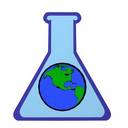Colors of Fall Leaves: Easy Science Projects
Learn about the colors of Fall leaves with these 3 simple, fun science projects.
NOTE: ADULT SUPERVISION IS REQUIRED. Please read all instructions completely before starting. Observe all safety precautions.
Table of Contents
Project 1 - Separate Colors in a Green Leaf using Chromatography
What you need:
- leaves, small jars (baby food jars work well)
- covers for jars or aluminum foil or plastic wrap
- rubbing alcohol, paper coffee filters
- shallow pan, hot tap water, tape, pen
- plastic knife or spoon, clock or timer.
What to do:
- Collect 2-3 large leaves from several different trees. Tear or chop the leaves into very small pieces and put them into small jars labeled with the name or location of the tree.
- Add enough rubbing alcohol to each jar to cover the leaves. Using a plastic knife or spoon, carefully chop and grind the leaves in the alcohol.
SAFETY NOTE: Isopropyl rubbing alcohol can be harmful if mishandled or misused. Read and carefully follow all warnings on the alcohol bottle. - Cover the jars very loosely with lids or plastic wrap or aluminum foil. Place the jars carefully into a shallow tray containing 1 inch of hot tap water.
SAFETY NOTE: Hot water above 150 F can quickly cause severe burns. Experts recommend setting your water heater thermostat no higher than 125 F. - Keep the jars in the water for at least a half-hour, longer if needed, until the alcohol has become colored (the darker the better). Twirl each jar gently about every five minutes. Replace the hot water if it cools off.
- Cut a long thin strip of coffee filter paper for each of the jars and label it.
- Remove jars from water and uncover. Place a strip of filter paper into each jar so that one end is in the alcohol. Bend the other end over the top of the jar and secure it with tape.
- The alcohol will travel up the paper, bringing the colors with it. After 30-90 minutes (or longer), the colors will travel different distances up the paper as the alcohol evaporates. You should be able to see different shades of green, and possibly some yellow, orange or red, depending on the type of leaf.
- Remove the strips of paper, let them dry and then tape them to a piece of plain paper. Save them for the next project.
Project 2 -Separate Colors in a Fall Leaf using Chromatography
What you need:
- Same as in Project 1
What to do:
- Repeat step (1)-(8) from Project 1, this time using leaves that have changed color. You may have to wait much longer in steps (4) and (7). There is normally much less of the other colors in the leaves compared to the green chlorophyll.
Project 3 -Observe how light affects color development
What you need:
- a tree with leaves that turn red in autumn
- aluminum foil or heavy paper and masking tape.
What to do:
- Before the leaves turn colors in the fall, find a maple tree, flowering dogwood, sweet gum, or other tree or shrub that you know will turn bright red or purple.
- Find several leaves that receive bright sunlight, and cover part of them with foil or heavy paper and tape.
- After the leaves have changed color, remove the covering and observe the different colors underneath. These are the colors that were in the leaf all summer. The bright reds and purples are only made in the fall, with exposure to light.


